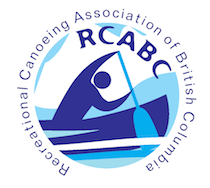
The river canoeing opportunities in British Columbia are nothing less than outstanding and RCABC encourages you to get outside and enjoy them! But BC's rivers require extra caution, gear and skills. The list of cautions is long, but they can all be managed very safely with training and an attitude towards safety.
RIVER CANOEING TOPICS:
- TAKE A COURSE AND GET LOCAL ADVICE
- THE RIGHT CANOE AND EXTRA FLOTATION
- COLD WATER
- WOOD DEBRIS
- CONTINUOUS RAPIDS
- RESCUES AND TEAMWORK
- PORTAGES
- STOWING GEAR
- RIVER GRADING
- RIVER RESCUE GEAR
TAKE A COURSE AND GET LOCAL ADVICE
Take an RCABC moving water course to prepare yourself for enjoying BC's amazing river diversity! Courses from experienced instructors are also excellent for fine tuning skills that you may need help with.See the RCABC canoe based River Rescue course for more information on river safety.
Get local advice from instructors, club members, guides or trusted paddlers. Be careful when getting advice from rafters or kayakers. Their advice is no doubt well meaning, but they often have a different view of rivers and rapids due to the nature of their craft. There are excellent guide books for many regions of BC.
Back to Top...
THE RIGHT CANOE AND EXTRA FLOTATION
We've seen the remains of a lot of old fiberglass canoes without floatation litering BC rivers. Get informed about the different types of materials available. Every reputable canoe manufacturer makes models appropriate for river canoeing, but there are many subtle differences. Which is more important to you....?
- Weight
- Durability
- Slipperyness on rocks and shallows
- Cost
- Ability to glue in anchors for outfitting
- Cosmetics
- Ability to solo
Generally a river canoe has some rocker for manouevreing and decent width and stability. Solo canoes come in many materials, shapes and sizes from 8' to 15'.
Whichever canoe you buy, adding extra flotation keeps the boat floating high in the water, preventing damage on rocks and making it much easier to rescue. The flotation chambers at the ends of fiberglass or kevlar canoes are not enough flotation!
BC Rivers are typically somewhere around or below 10 degrees Celsius, sometimes a bit warmer but often colder, down to just above freezing. This is very cold. A drysuit is a great investment for BC river paddling!
Back to Top...
Most BC rivers flow in valleys of glacial and river deposits with lots of forest and vegetation. High water is constantly undercutting banks and creating new channels. Lots of wood debris ends up in the water in the form of sweepers, strainers, log jams, sunken wood, etc. Every year people die in this wood debris on BC rivers. It can always be managed safely by watching for it, paddling carefully or walking around it.
Back to Top...
CONTINUOUS CURRENTS AND RAPIDS
There is little "drop and pool" river character in BC compared to Eastern Canada. Rapids are typically followed by more fast moving water or more rapids. Currents can be relentless. Boulder gardens are very common, with some rivers being almost continuous boulder gardens. Some areas of BC have ledges, particularly in the eastern areas associated with the Rocky Mountains. Of course this is why we like BC rivers so much, but they demand respect.
Back to Top...
Canoeists should paddle as a team, scout ahead and use signals to communicate. Rescues and self rescues should be quick and and reasonably familiar.
Back to Top...
Carrying around rapids on BC rivers can sometimes be difficult and there often aren't established trails. Some common routes have established portage routes. Many rivers with waterfalls or rapids too difficult to navigate are in tight canyons with very difficult escape options, sometimes on perpetually wet and mossy rock. Many trails are in coastal or interior rainfall areas grow over very quickly. Get local advice or scout before attempting rivers that have 'must make' portages.
Back to Top...
Gear needs to be stowed properly. The best approach is to tie your gear in securely. Make sure it doesn't hang below your gunwales if the canoe is upside down or it may drag and catch while floating and it makes canoe over canoe rescues very difficult. A well outfitted river canoe has many anchor points attached to the inside of the hull to facilitate gear tie down. Letting your gear float free is an option, but there is some risk of losing it. If you let gear float free keep it in large, easy to manage packages and not lots of small pieces. Typically it stays near the canoe and rescue scene but can sometimes go on it's own journey.
Back to Top...
The International River Grading System defines river from Grade one (I) to six (VI). Grade III is the typical limit for open canoes. Grade IV rapids and even Grade V have been run, typically in solo whitewater canoes or C-1s, but not often.
River grade and difficulty typically increases with water level. Note that very old guidebooks and maps often graded rivers higher if low water temperature and remoteness were factors. These are serious aspects to consider, but they are no longer part of the grading system.
Back to Top...
A throw bag with high strength, floating rope should be carried in every canoe. Canoeists should have at least one 'wrap kit' in their group. A wrap kit should contain a few webbing slings, carabiners, pulleys, prusik loops. Other good equipment to have is a easily accessible knife in or on your PFD and a small, light folding saw in one canoe. River trippers could carry an extra long rescue line, especially in remote settings.
Back to Top...



















